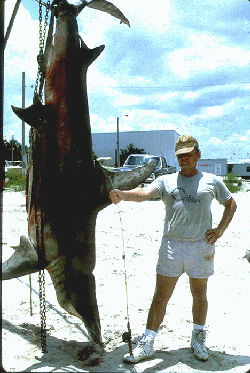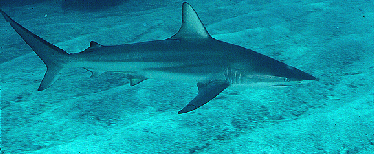Say the word “shark” and the first image most people conjure up is a Jaws-inspired white shark devouring unsuspecting bathers while well-meaning authorities and scientists helplessly stand by.

Shark attack is probably the most feared natural danger to man, surpassing even hurricanes, tornadoes and earthquakes in the minds of most beach users and sailors. Among the earth’s large animals implicated in the attack and consumption of humans, only sharks have not been “controlled” by man.
Even the fiercest of terrestrial predators, the large cats and bears, are extremely susceptible to a rifle and “problem” animals simply have been eliminated, leaving many of these species endangered. Some crocodilians, especially the Nile and saltwater crocodiles, are certainly as dangerous as sharks, but these reptiles have never captured as much “press” in part because their populations are largely limited to Third World countries and they, too, are vulnerable to human hunting pressure.
The sea’s only other creatures with the capability of consuming a human, killer and sperm whales, are not normally considered threats to man. Sharks, on the other hand, have been documented attackers (and sometime consumers) of humans around the world throughout recorded history.

Shark attack did not become a subject of particular public interest until the twentieth century. Several factors have contributed to the upswing in public awareness of shark attack during the last sixty years. First and foremost has been the evolution of the press from a parochial to a cosmopolitan news-gathering system that covers a larger portion of the world in a more rapid and comprehensive manner.
Increased competition and a shift of journalistic values in certain quarters additionally has contributed to more active searches for “shock” stories, i.e. those that titillate the public and promote sales. Needless to say, an examination of current weekly tabloids confirms that “shark eats man” is a best-selling story line. World War II, with a plethora of air and sea disasters never before encountered during previous confrontations or in peacetime, regrettably spawned large numbers of shark attacks and spurred research to find an effective shark repellent.
The general worldwide trend towards more intense utilization of marine waters for recreational activities during this time period has also increased the chances of shark-human interactions with a resulting increase in the total number of attacks. Add in fictionalized shark accounts in the popular press and movies and it’s easy to see why shark attack is a hot topic.
Shark attack is a potential danger that must be acknowledged by anyone that frequents marine waters, but it should be kept in perspective. Bees, wasps and snakes are responsible for far more fatalities each year. In the United States deaths occur up to 30 more times from lighting strikes per year, than from shark attacks per year. For most people, any shark-human interaction is likely to occur while swimming or surfing in nearshore waters. From a statistical standpoint the chances of dying in this area are markedly higher from many other causes (such as drowning and cardiac arrest) than from shark attack.
Many more people are injured and killed on land while driving to and from the beach than by sharks in the water. Shark attack trauma is also less common than such beach-related injuries as spinal damage, dehydration, jellyfish and stingray stings and sunburn. Indeed, many more sutures are expended on sea shell lacerations of the feet than on shark bites!

Nevertheless, shark attack is a hazard that must be considered by anyone entering the marine domain. As in any recreational activity, a participant must acknowledge that certain risks are part of the sport: jogging offers shin splints, camping brings ticks and mosquitoes, tennis may result in sprained ankles, and so on. Beach recreation has its inherent risks as well, and shark attack is simply one of many that must be considered before entering the water. Most people agree, however, that the extremely slim chance of even encountering a shark – much less being bitten – does not weigh heavy in their decision-making.
[Reprinted, with emendations, from: Burgess, G.H. 1991. Shark attack and the International Shark Attack File, pp. 101-105. In: Gruber, S.H. (ed.). 1990. Discovering Sharks, American Littoral Society, Highlands, New Jersey]